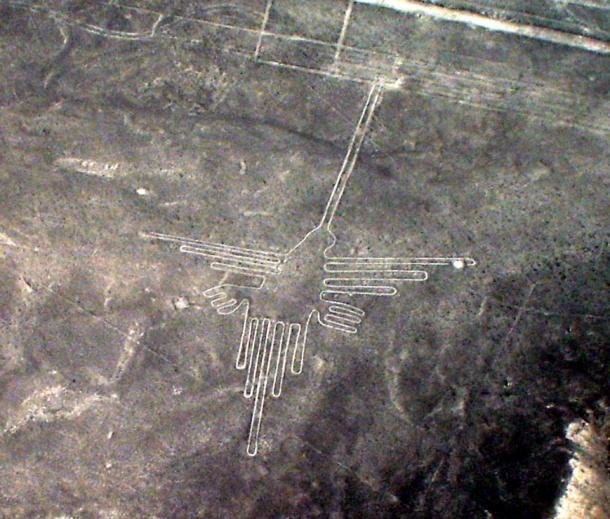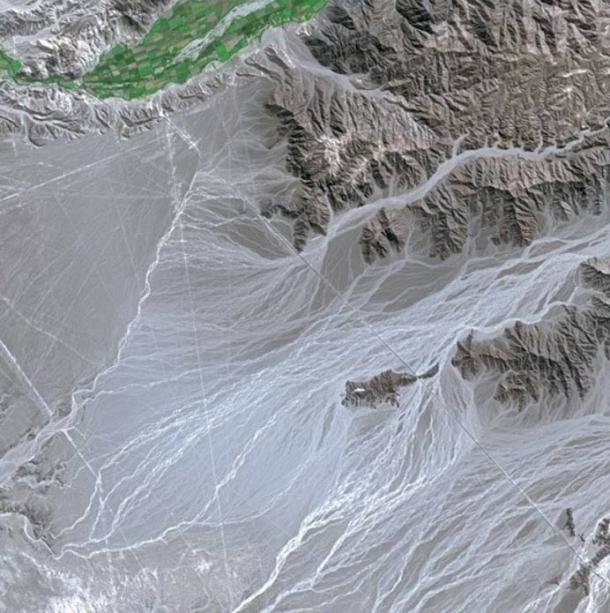
© Wikipedia – ( CC-BY-SA-3.0)The Hummingbird Geoglyph of the Nasca Lines, Peru.
Evidence taken from iconography and inscriptive material leads William to hypothesize that the three independent features may have been created by the same Trans-Oceanic Peoples from the Continent of West Africa and the Mediterranean Region.
As an Archaeoastronomer my primary research interest has always been associated with the famous Nasca Lines. Apart from research to determine if the Nasca Lines were astronomically orientated, I studied the unique surface variation of shales and gravels 'sand painted' within and around the gigantic geoglyphs; an art form that goes back many centuries—even to Ancient Egyptian times.

© CC BY-SA 3.0The incredible, Nasca lines of Peru - seen from SPOT Satellite.
Nasca's massive cleared areas called geoglyphs were long believed by many, including myself, to have been elaborated for the sole purpose of ritual or ceremonial displays. However, back in the late 70's I obtained a copy of an excellent book by author Tony Morrison, entitled
"Pathways to the Gods"; this book became my bible for some considerable time.
Later, other authors climbed aboard the Nasca Lines phenomenon, many peddling their mindless speculation which completely confused the real purpose behind what has become one of Peru's National treasures.
One particular photograph in
"Pathways" immediately caught my eye (page 39). A huge 475-meter-long (1560 feet) trapezoid described as having 'long rows of stone piles '; 'the small heaps of stones were arranged in two main rows, one each side of the center'
( After Morrison
).This geoglyph located on the Socos Pampa, just north of the Nasca Valley, was thought to be a cleared area in the course of elaboration, or perhaps, the stone heaps were the remains of a tally system accounting stores of goods and crops, or labor. But the seemingly illogical pattern of the stone heaps did not convey, to me anyway, this impression.
Socos Pampa trapezoidUnconvinced, I purchased a copy of the original aerial photograph from
South American Pictures to minutely examine the entire length of the feature through an optical viewer I had designed especially for the purpose of photo-recording tonal variations created by the artistic manipulation of small rocks, shale and gravels within and between Nasca geoglyphic structures.
Almost immediately I was rewarded. Small heaps of stones were piled up on the surface, i.e. 'additively' constructed, to form pictographs interspersed by sets of strange symbols; this was a never-before-seen or even known phenomenon occurring, of all places, within the Nasca Lines. (View on Google Earth:
Latitude 14 49 18S, Longitude 75 00 20W , Ocungalla, Nasca River Valley)
Agreed, the famous creature-like biomorphs; the hummingbird, the whale, the spider etc. making up the Nasca Lines are world famous, but a trapezoid embellished with pictorials and inscriptive material is unbelievable because no known form of 'written' communication had ever been discovered relative to pre-Columbian Peru. To preserve and protect this extremely unique discovery I photo-recorded where possible each set of regalia and inscriptions along the length of the trapezoid in question.
Read entire article
here
See www.jmccanneyscience.com, James McCanney's website, for his 'suggestion' concerning the nature and intention of the Nazca lines. He put up a PDF titled The Nazca Lines - Mystery Solved. You will not regret the clicks.